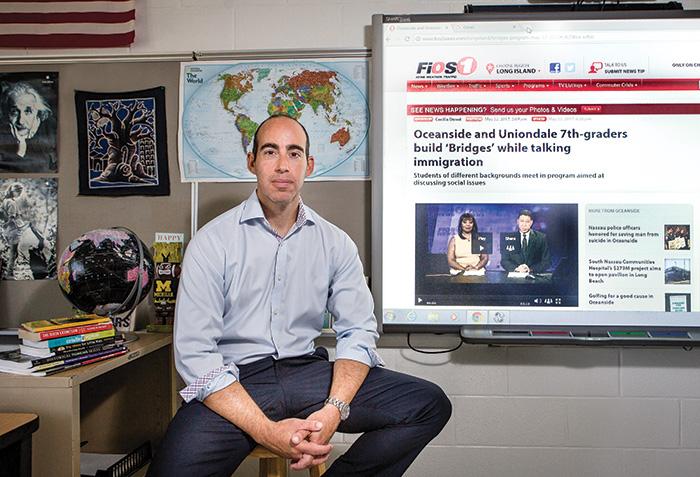Meet Mitch Bickman, the director of K–12 social studies for Oceanside School District in Oceanside, New York. Bickman is passionate about offering opportunities for students to think critically, engage in thoughtful dialogue and make real-world connections. In 2016, the New York State Social Studies Supervisory Association named him the Supervisor of the Year.
What inspired you to become a social studies educator?
It was both my experience in high school and a teacher I had as a junior in high school whose name is Carmine Verde. He was my U.S. history teacher, and his passion and enthusiasm for a subject that I already enjoyed was something that definitely sparked something in me that said, “This is the career I might want to pursue.”
During the 2016-17 school year, you started a program called Bridges, through which 60 students from different schools will spend six years, grades 7–12, in dialogue with each other about social issues. How did this program come about?
In December of 2015, I was contacted by a professor out of Hofstra University who was actually my professor in grad school, Alan Singer. He said, “I’d love to have a dialogue between Oceanside and Uniondale,” which is one of our neighboring districts. Oceanside High School is about 85 percent white, and Uniondale High School is closer to 97, 98 percent Latino and African American. He said he wanted to have a conversation between seniors, government students, about race in America.
These 17- and 18-year-olds had about an hour-and-a-half dialogue that was raw, it was powerful, it was emotional at times. As powerful as this experience was for students, the problem was that it was a one-off.
That planted a seed for me, saying, “How can we not only replicate these conversations and interactions but create something more meaningful than a one-time dialogue?” I reached out to Uniondale’s chair of social studies and we had a conversation, and then I reached out to a few of our Oceanside teachers who I thought would be perfect partners in this program. That’s essentially where Bridges was born from.
The kids have been just so open to this experience. You don’t see students too often sitting across from a peer and just intently listening [to] their thoughts, their views, their conversation and then weighing those thoughts and responding thoughtfully to them. Ultimately, this will culminate in a service-learning project that students will determine in their sophomore year and execute in their junior and senior years.
You run a program called Big Ideas for Little Kids. What is its goal?
The goal of this program is to expose students, as young as kindergarten, to philosophical thinking and to build a framework for questioning and thinking.
Big Ideas for Little Kids was named after the same book by Tom Wartenberg out of Mount Holyoke College and he’s a philosophy professor. We mirrored his work: What he does with college students is he pushes into elementary classrooms and has philosophical discussions with his students being the ones leading the discussions.
When we read books about bravery with K–6 students and ask them what it means to be brave, their first thought more often than not—especially in grades K, 1 and 2—is that bravery means someone is strong. During these discussions, something magical happens and we see this evolution where their definition of bravery expands. And by the time we’re done with this 30-minute conversation, bravery can mean running away. Bravery can mean all these other things that they didn’t initially think about.
We have now, over the past three years, worked with four of our six elementary schools across grades K–6. And by next year, we’ll hit our last two elementary schools, and then our plan is for this to just become part of the curriculum.
In the Big Ideas for Little Kids program, readings include Margaret Wise Brown’s The Important Book, Arnold Lobel’s Frog and Toad series and Shel Silverstein’s The Giving Tree.
During the 2017-18 school year, what lessons or themes do you think students should be exposed to in their social studies classes?
One of the things we’re looking to embed more purposefully into the curriculum is real-world problems that the students could investigate through an inquiry-model approach and look to tackle and possibly solve or propose solutions.
Another big goal of ours is to focus more on dedicated instruction of media literacy. Of course, a hallmark of social studies education is always to look at the validity or reliability of sources, which we have been doing for a very long time. But it’s taken on an added urgency and importance, given both the climate of our nation and things we’re seeing in the world today.
Mitch Bickman is the director of K-12 social studies for Oceanside School District.
Know an excellent administrator, librarian or counselor we should interview?
Tell us all about them.

